
NHPRC News - October 2010
NHPRC News
October 2010
In This Issue:
Inside the Commission
November Meeting
The November meeting of the National Historical Publications and Records Commission is scheduled for Friday, November 19, 2010 at the National Archives. The meeting begins at 9 a.m. in the Archivist's Board Room, 700 Pennsylvania Avenue, NW, Washington, DC, and it is open to the public. If you wish to attend, please contact Christine Dunham at christine.dunham@nara.gov at least one week prior to the date so that you may be put on the guest list.
Jeff de la Concepcion, Grants Program Specialist
On August 30th, Jeff de la Concepcion started with the NHPRC as the Grant Program Specialist. Prior to arriving at NARA, Jeff was a Federal Government Contractor, serving as the American Recovery and Reinvestment Act Grant Management Project Manager at the Department of Justice's grants program. He was responsible for managing the grant life-cycle for the ARRA grants as well as supporting all law enforcement grants at DOJ. Jeff will be managing the grants process--from the ingestion of applications from Grants.gov to monitoring successful projects through the Grants Management System.
Legislative Update
In late July, the Senate Financial Services and General Government Appropriations Committee recommended $10 million for the National Historical Publications and Records Commission for FY 2011. This amount is $3 million below the fiscal year 2010 enacted level and the same as the budget request.
"The Committee strongly supports the NHPRC program and has provided funding to continue this important program. This program has played a central role in the preservation and dissemination of the Nation's documentary heritage and has been successful in leveraging private sector contributions."
"The Committee notes that the funding provided will enable NARA, through the NHPRC, to undertake a variety of initiatives, including advancing archives preservation, access, and digitization projects within the interlocking repositories of historic records and hidden collections; ensuring public access to some of the most important historical resources that are maintained outside of Federal repositories; and digitizing nationally significant historic records collections to facilitate round-the-clock Internet availability."
Grant Deadlines
The following Grant opportunities are currently available online:
-
Archives - Basic Projects
Final Deadline: October 7, 2010 -
Archives - Detailed Processing Projects
Final Deadline: October 7, 2010 - Historical Editing Fellowships
Final Deadline: October 7, 2010 -
Professional Development Grants
Final Deadline: October 7, 2010 -
Publishing Historical Records: New Republic through Modern Era
Final Deadline: October 7, 2010
Go to Grant Opportunities for more information.
News from our Grantees
Archives Month
October is Archives Month! Once again archives all across the country are celebrating October as Archives Month with special events and activities designed to raise public awareness of the role of archives in our daily lives. The Council of State Archivists keeps a running tab of events in participating states, and several state archival organizations have produced posters to mark the occasion. More info can be found at http://www.statearchivists.org/archivesmonth/AAM-directory.htm.
As part of Archives Month, the National Archives and Records Administration, in conjunction with the DC and Maryland Caucuses, invite you to the 2010 Archives Fair. Connect with regional archivists and archival repositories on Wednesday, October 27 at the National Archives by sharing information about our diverse collections at the 14th Annual Washington, DC, Metropolitan Area Archives Fair.
The events will take place at the William G. McGowan Theater Lobby, 7th Street and Constitution Avenue, NW, Washington, DC, from 9am to 1pm, and the NHPRC will be on hand to share information about grants. This year's program features Archivist of the United States, David S. Ferriero, who will moderate a panel discussion by U.S. Government agency historians related to the role historians play in their agencies.
Papers of the War Department
On the night of November 8, 1800, fire raced through the offices of the War Department on Pennsylvania Avenue in Washington, DC, destroying the office and all of its files. For nearly two centuries, historians believed that the collection, and the window it provided into the workings of the early federal government, was lost forever.
More than a dozen years ago, Ted Crackel began an effort to reconstitute the War Department Papers, and it has involved years of painstaking work, including visits to more than 200 repositories and the consulting of more than 3,000 collections in the United States, Canada, England, France, and Scotland. In early 2006, the project was transferred to the Center for History and New Media at George Mason University, which is working to realize Crackel's original vision. Indeed, perhaps uniquely among U.S. institutions, Mason combines the scholarly, technical, and institutional qualities (including substantial staff with credentials in military history, the history of the early republic, historical editing, and especially digital history) necessary to complete the project in a professional and timely manner.
These Papers record far more than the era's military history. Between 1784 and 1800, the War Department was responsible for Indian affairs, veteran affairs, naval affairs (until 1798), as well as militia and army matters. During the 1790s, the Secretary of War spent seven of every ten dollars of the federal budget (debt service excepted). The War Office did business with commercial firms and merchants all across the nation; it was the nation"s largest single consumer of fabric, clothing, shoes, food, medicine, building materials, and weapons of all kinds. "Follow the money," it is said, if you want to learn what really happened, and in the early days of the Republic that money trail usually led to the War Office. For example, the War Department operated the nation's only federal social welfare program, providing veterans' benefits (including payments to widows and orphans) to more than 4,000 persons. It also provided internal security, governance, and diplomacy on the vast frontier, and it was the instrument that shaped relations with Native Americans. In many respects, the papers lost in the War Office fire of 1800 constituted the "national archives" of their time.
An initial pass through the entire archive shows that the total collection numbers over 45,000 documents. In June 2008, a website was launched at www.wardepartmentpapers.org that allows visitors access to digital images of documents as well as generating feedback from scholars, teachers, and others, offering copies of documents they know to be missing.
In the spring of 2010, the NHPRC awarded the project a new grant to continue adding much more detailed data to the index for the collection. One of the more interesting aspects of this work is the Center for History and New Media's approach to data entry and indexing harnessing the power of individual users and enabling them to upload transcriptions to the site through "crowdsourcing."
Civic Engagement Collections in Pennsylvania
Matthew Lyons, Historical Society of Pennsylvania
Through a grant from the NHPRC, the Historical Society of Pennsylvania has begun a a new 26-month project to process and conserve fourteen collections related to civic engagement in Philadelphia and beyond. Willhem Echevarria has already started work as project archivist, and in December he will be joined by Leah Mackin as project preservation technician. Previously, both Willhem and Leah worked on our Chew papers project and Digital Center for Americana pilot project, and we're fortunate that they'll be continuing on with this new initiative.
The project deals with collections documenting a wonderful variety of people and organizations. These range from Albert Greenfield (real estate broker turned banker, politician, and philanthropist) to Morris Milgram (socialist activist turned integrated housing pioneer and developer of planned communities); from Anthony Biddle, Jr. (elite-born diplomat and military officer) to Max Weiner (who helped launch a grassroots consumer protection movement in the 1960s). The project includes the papers of reformers across three generations: Herbert Welsh, who from the 1870s to the 1930s tackled everything from imperialism to forestry to civil service rules; Richardson Dilworth and Natalie Saxe Randall, who helped lead Philadelphia's political reform movement after World War II; and John Fryer, psychiatrist and gay rights activist, who in 1972 helped persuade the American Psychiatric Association to remove homosexuality from its list of mental disorders.
Organizational collections in the project include the records of the Citizens' Permanent Relief Committee, a late 19th century philanthropic group that aided people harmed by natural disasters, famine, war, or political repression; and the Indian Rights Association, which played a key lobbying role from the 1880s to the 1930s around its paternalistic aim to "bring about the complete civilization of the Indians and their admission to citizenship." There are also six decades of records of the League of Women Voters of Philadelphia, which promoted women's political participation and took stands on issues ranging from child care and public education to the United Nations and the Marshall Plan.
I'm especially pleased that this project will enable us to digitize 160 hours of phonograph recordings from the Philadelphia Fellowship Commission, a pioneering civil rights coalition formed in 1941. To help promote its multi-cultural ideals, in the 1940s and 50s the commission sponsored a series of radio plays, stories, and interviews with people of diverse racial, ethnic, and religious backgrounds. The Civic Engagement project will make these recordings publicly accessible for the first time since they were broadcast.
Implementing "More Product, Less Process" (MPLP)
The Civic Engagement project is funded primarily by the National Historical Publications and Records Commission (NHPRC), the grant-giving arm of the National Archives and Records Administration. The NHPRC has gone farther than any other major archives funder in embracing MPLP principles. To get NHPRC funding for a "detailed" processing project, including any descriptive work below the collection level, a repository has to ensure that virtually all of its collections are or will soon be open for research and locatable online. This embodies one of MPLP's key tenets, that repositories should provide a basic, minimum level of access to all their collections before giving intensive attention to a select few. HSP's Archives Department wholeheartedly endorses this approach. For the first time ever, we will soon provide online collection-level descriptions for all our archival holdings, through a new online guide that will launch later this year.
Processing work on the Civic Engagement collections will be based on MPLP principles as well. This means that some practices will be streamlined to speed up processing and make more collections accessible more quickly. For example, collections may receive only rough arrangement below the sub-series level. Non-archival folders will be replaced only if they are damaged or do not fit in an archival box. And, yes, metal fasteners will be removed only if they are rusty or pose a hazard to users. Staff time for this project has been allocated based on an average of 2.6 hours per linear foot for processing work and 1.25 hours per linear foot for conservation work. HSP has five different processing levels that we use depending on the specific collection, and guidelines for this project are based on our Level 3 protocol, in the middle of the range.
Contributing to a regional effort
The Civic Engagement project is interconnected with a consortial processing project that HSP is participating in. The PACSCL Hidden Collections project, funded by the Council on Library and Information Resources, is processing collections at 24 institutions, including HSP. (PACSCL stands for Philadelphia Area Consortium of Special Collections Libraries.) The two projects share the same processing methodology and were developed in close coordination with each other. HSP staff helped design the PACSCL project, establish its standards, and write its manual. PACSCL project staff, in turn, has helped to train HSP staff in the use of MPLP principles and Archivists' Toolkit. Two collections in the Civic Engagement project (League of Women Voters of Philadelphia and the World War II collection) will be processed by PACSCL project staff at HSP, working alongside HSP staff. This type of interchange enriches our work and helps us see our tasks as part of a regional effort.
Alan Chesney and Hopkins Medical Archives
In neatly catalogued boxes in Johns Hopkins's Medical Archives lie faded letters, photographs and documents from long-ago physicians. Without them, much of the story of 20th-century medicine would be lost. Through the foresight of one physician, a treasure was saved.
A native of Baltimore, Alan Mason Chesney received his A.B. in 1908 from the Johns Hopkins University and his M.D. in 1912 from the School of Medicine. After serving in the Medical Corps of the U. S. Army during World War I and working as head of the infectious disease division of the department of medicine at Washington University in St. Louis, Chesney returned to Johns Hopkins in 1921 to direct the newly formed syphilis division. His studies in syphilis have influenced all subsequent studies in the area. He became dean of the school of medicine in 1929, serving for twenty-four years. While dean, he began working on a three-volume history, The Johns Hopkins Hospital and the Johns Hopkins University School of Medicine: A Chronicle. Chesney's efforts to preserve the early records that he located in his research resulted in the establishment in 1978 of the archives which bears his name.
The Alan Mason Chesney Medical Archives of the Johns Hopkins Medical Institutions documents education, research, and healthcare delivery; their governance and administration of the Johns Hopkins Medical Institutions; biographies of more than 200 faculty, staff, and alumni; and cultural properties of the Institutions. Among its holdings are 30,000 historic photographs and several thousand objets d'art and artifacts, including a major portrait collection.
A grant in the mid-1980s from the NHPRC enabled a three-year project to initiate a records management program for the four major Johns Hopkins Medical Institutions and to produce a guide to the management of medical records. More recently, the NHPRC awarded a grant to support the Medical Archives role within the overall electronic records system strategy at Johns Hopkins.
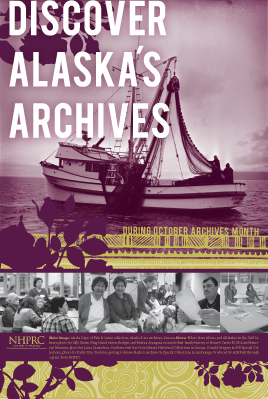 Alaska s poster celebrating October as Archives Month.
Alaska s poster celebrating October as Archives Month. 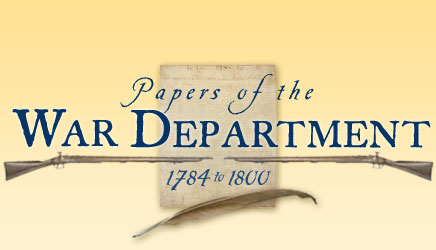 Logo for the Papers of the War Department at George Mason University.
Logo for the Papers of the War Department at George Mason University. 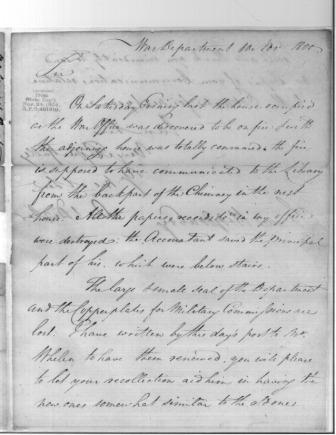 Letter from Secretary of War Samuel Dexter to Samuel Hodgdon in Philadelphia, November 10, 1800. This letter discusses the loss of records that occurred as a result of the fire that consumed the War Department. Dexter asks Hodgdon to provide copies from his records to assist present business. National Archives and Records Administration: Post Revolutionary War Papers, RG94
Letter from Secretary of War Samuel Dexter to Samuel Hodgdon in Philadelphia, November 10, 1800. This letter discusses the loss of records that occurred as a result of the fire that consumed the War Department. Dexter asks Hodgdon to provide copies from his records to assist present business. National Archives and Records Administration: Post Revolutionary War Papers, RG94 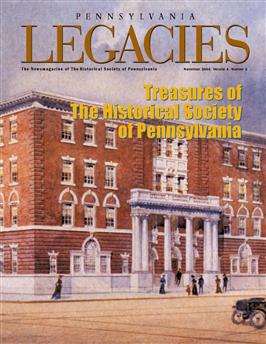 Cover of the Historical Society of Pennsylvania s journal Pennsylvania Legacies depicting the HSP building in Philadelphia.
Cover of the Historical Society of Pennsylvania s journal Pennsylvania Legacies depicting the HSP building in Philadelphia. 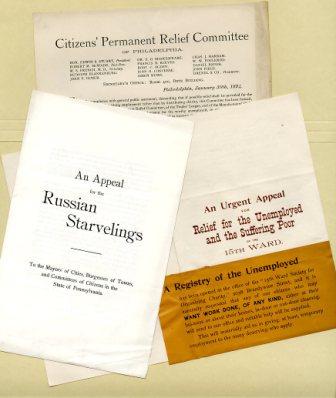 Flyers from Citizens Permanent Relief Committee records, ca. 1890s, Historical Society of Pennsylvania
Flyers from Citizens Permanent Relief Committee records, ca. 1890s, Historical Society of Pennsylvania 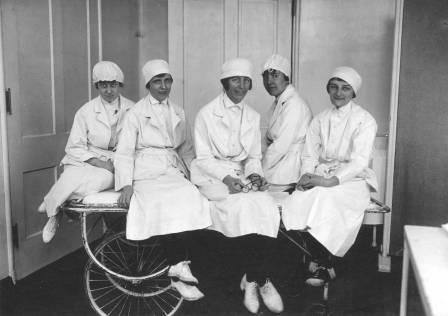 In 1922, these graduates of The Johns Hopkins Hospital School of Anesthesia for Nurses were some of the first nurses to receive continuing education at Hopkins. The Alan Mason Chesney Medical Archives of The Johns Hopkins Medical Institutions
In 1922, these graduates of The Johns Hopkins Hospital School of Anesthesia for Nurses were some of the first nurses to receive continuing education at Hopkins. The Alan Mason Chesney Medical Archives of The Johns Hopkins Medical Institutions